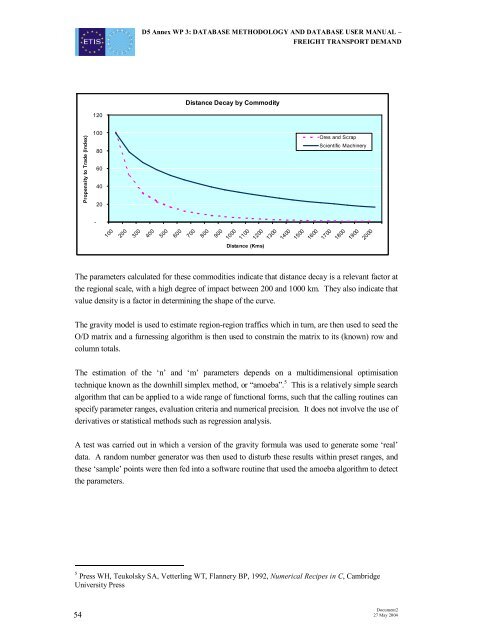D5 Annex report WP 3: ETIS Database methodology ... - ETIS plus
D5 Annex report WP 3: ETIS Database methodology ... - ETIS plus
D5 Annex report WP 3: ETIS Database methodology ... - ETIS plus
Create successful ePaper yourself
Turn your PDF publications into a flip-book with our unique Google optimized e-Paper software.
<strong>D5</strong> <strong>Annex</strong> <strong>WP</strong> 3: DATABASE METHODOLOGY AND DATABASE USER MANUAL –<br />
FREIGHT TRANSPORT DEMAND<br />
Distance Decay by Commodity<br />
120<br />
Propensity to Trade (Index)<br />
100<br />
80<br />
60<br />
40<br />
20<br />
Ores and Scrap<br />
Scientific Machinery<br />
<br />
100<br />
200<br />
300<br />
400<br />
500<br />
600<br />
700<br />
800<br />
900<br />
1000<br />
1100<br />
1200<br />
1300<br />
1400<br />
1500<br />
1600<br />
1700<br />
1800<br />
1900<br />
2000<br />
Distance (Kms)<br />
The parameters calculated for these commodities indicate that distance decay is a relevant factor at<br />
the regional scale, with a high degree of impact between 200 and 1000 km. They also indicate that<br />
value density is a factor in determining the shape of the curve.<br />
The gravity model is used to estimate regionregion traffics which in turn, are then used to seed the<br />
O/D matrix and a furnessing algorithm is then used to constrain the matrix to its (known) row and<br />
column totals.<br />
The estimation of the ‘n’ and ‘m’ parameters depends on a multidimensional optimisation<br />
technique known as the downhill simplex method, or “amoeba”. 5 This is a relatively simple search<br />
algorithm that can be applied to a wide range of functional forms, such that the calling routines can<br />
specify parameter ranges, evaluation criteria and numerical precision. It does not involve the use of<br />
derivatives or statistical methods such as regression analysis.<br />
A test was carried out in which a version of the gravity formula was used to generate some ‘real’<br />
data. A random number generator was then used to disturb these results within preset ranges, and<br />
these ‘sample’ points were then fed into a software routine that used the amoeba algorithm to detect<br />
the parameters.<br />
5<br />
Press WH, Teukolsky SA, Vetterling WT, Flannery BP, 1992, Numerical Recipes in C, Cambridge<br />
University Press<br />
54<br />
Document2<br />
27 May 2004
















